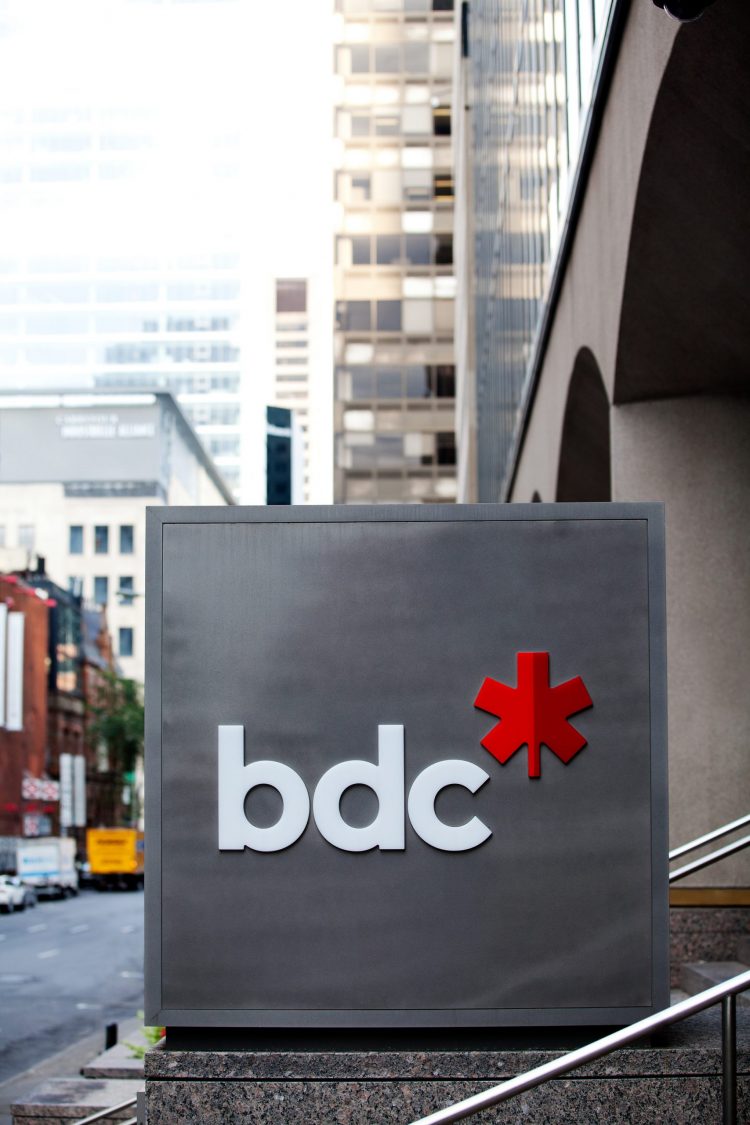A Case Study in Crisis Response

The Business Development Bank of Canada—a Crown corporation that operates at arm’s length from the federal government—has directly provided more than $2.5 billion in COVID working capital loans and more than 40,000 postponements to clients since the pandemic lockdown hit. It has also been a key player in Canada’s whole-of-government COVID-19 response. Here’s how the bank’s leadership and employees responded, adapted and rallied to meet a sudden upsurge in demand for service and capital while themselves adjusting to the new demands of working in a pandemic.
Michel Bergeron
When the COVID-19 pandemic swept through Canada in early March, shock waves of worry rippled through the country’s small businesses. Many of them looked to the Business Development Bank of Canada (BDC)—as the first place to get help. Having served small and medium-sized businesses for more than 75 years, through the credit crisis of 2008-2009 and the 2015 oil crash, BDC was ready to respond.
Within the first three weeks, BDC received more loan applications than it normally gets in a year. Within two months, its staff had fielded more than 20,000 telephone calls from business owners, and more than a million people visited the bank’s website. By mid-June, BDC’s 30-day direct lending volume for working capital loans peaked at more than 14 times above baseline, in dollar terms. At a time when BDC’s mission was critical to support entrepreneurs and the Canadian economy, the bank also faced logistical, technological and human resources challenges of its own. “We weren’t scaled or staffed to handle that unprecedented volume,” recalls Christopher Rankin, Executive Vice-President and Chief Risk Officer at BDC. “We had to adapt quickly.”
In a few short weeks, BDC implemented a strategy to develop and deliver COVID-specific product enhancements, redeployed hundreds of employees to address demand and improved and accelerated its processes to broaden its reach. As well, the bank had already begun a digital transformation to better support clients and employees, but the pandemic and the volume of loan requests put the project on the front burner. Today, more than six months after the first days of the crisis, BDC—a financially sustainable Crown corporation that operates at arm’s length from the federal government, its sole shareholder—has directly provided more than $2.5 billion in COVID working capital loans and more than 40,000 postponements to clients. It now directly supports 62,000-plus entrepreneurs, an increase of more than 8,000 business owners. And it has been a key player in Canada’s whole-of-government COVID-19 response, leading the way in the delivery of two new programs under the Business Credit Availability Program umbrella to help entrepreneurs meet their operational cash flow requirements.
For BDC internally, fulfilling its mandate in the time of COVID-19 involved much more than adapting to a short-term surge in applications and requests. It also meant leveraging its technology and HR programs to ensure its 2,400 staff could work seamlessly from home and best serve entrepreneurs; collaborate on relief programs with government and private-sector partners; and maintain the morale and the health of its team. The story of how it did that provides something of a case study in organizational response to crisis—a response that could put the bank and its clients in a stronger position well into the future.
Of course, early in the pandemic, meeting the immediate needs of clients came first. In response, BDC further expanded its risk tolerance for loans and streamlined its application review processes. The crisis, says Rankin, “forced us to make even quicker decisions.” Meanwhile, the bank retrained and redeployed about 500 staff to help address the surge in customer requests and loan application processing. “Some IT people, employees on the marketing team and others were retrained and processing loans, talking to clients about the status of requests, and taking on other tasks above and beyond their normal duties,” says Dominic Vaillancourt, Assistant Vice-President, Business Solutions.
Dwayne Dulmage, BDC’s Lead Digital Transformation Officer, was vacationing in Florida in early March, but cut his family trip short when the crisis hit. “We all rallied to the cause,” he recalls. “We stopped what we were doing to focus on what we could do to help.” Before COVID, Dulmage’s team was executing on an ambitious strategy to transform BDC’s digital capabilities, but the crisis sped up their efforts. One key initiative already in the works was the automation of small (under $100,000) loan processing, whereby entrepreneurs could apply for a loan and have it authorized in real-time. Today, BDC’s online lending experience enables accelerated loan processing, and almost every step—from verifying eligibility to adjudicating credit and exchanging e-signatures, is now automated—the first digital offering of its kind to market in Canada. “We can now authorize small loans more quickly and efficiently, better supporting our clients,” Dulmage notes.
Such innovations, along with other projects BDC’s IT team is working on, point to something of a silver lining in the COVID cloud: the crisis has underscored the need for digital transformation not just as process improvement, but as risk mitigation. “The crisis made it obvious that we needed to accelerate our efforts,” says Dulmage. “We are all cognizant of the risk of a second wave and the need for a more responsive reaction than financial institutions were capable of during the first wave. Before the pandemic, digital transformation might have seemed conceptual to some people, but we have seen how it can improve the process for our clients—and why investments in it are so important.”
While BDC put “all hands-on-deck” to meet the needs of clients, it soon had another task: helping the federal government fulfill its commitment to support businesses. As a participant in Canada’s COVID-19 Economic Response Plan, BDC worked with public- and private-sector partners to develop and deliver several new programs under the Business Credit Availability Program, including the Co-Lending Program for small and medium-sized businesses and the Mid-Market Financing Program for medium-sized and larger businesses. And it had to do so in short order. “We had just started to find our footing and now we had to work with partners to create these new programs,” recalls Rankin. “Historically, it can take up to nine to 12 months to develop a new lending program. From design to implementation, we and our partners negotiated and built them in approximately 30 days.”

In administering these programs, BDC worked closely with other financial institutions, through whom entrepreneurs apply for and receive loans. In normal times, ironing out the terms of such relationships could take several months, but BDC and its partners had to manage it in a matter of weeks. BDC’s approach was straightforward: clear away the red tape and get it done. A standing working group kept the negotiation process streamlined, the partners quickly defined common goals, and they committed to being transparent about what they could—and couldn’t—do throughout the process. “It worked well because we stuck to those three things,” Rankin says.
Such rapid response also put new demands on employees’ time and expertise, all while they immediately started to work from home. BDC leadership recognized that maintaining staff morale—and their ability to work—would be vital. Using internal communications tools, senior leaders regularly provided updates and emphasized that the health of team members was their top priority. They took a flexible approach to work hours to accommodate staff with children and other care needs. The bank also ensured employees had access to home office equipment, reinforced available virtual health and mental health care supports, and expanded the availability of digital tools to keep in touch.
For Vaillancourt and the Business Solutions team, those proactive moves proved vital to helping them adapt to a different way of working—even as they had more work to do. Prior to COVID, most team members came to the main office every day, because they work in close collaboration; when COVID hit, Vaillancourt was concerned remote work would adversely impact productivity, especially for special projects. But the opposite occurred. “People did more than they usually did, because they care about our mission,” he says. “We actually saw our productivity, in many cases, increase, delivering bank-prioritized initiatives.”
The crisis had another unforeseen impact: it strengthened an already strong esprit de corps. Internal surveys have repeatedly shown the bank’s mission is a prime motivator for employees, and during COVID that motivation only seemed to increase. Employees worked long hours to help with backlogs, delayed retirement to pitch in, and continually looked for ways to improve the client experience. “It’s been unbelievable how committed people are to the success of our clients,” says Vaillancourt.
Rankin agrees. “The team realized the impact they could have on the economy and on our clients’ bottom line,” he says. “Coupled with adrenaline, this belief in our mission carried us through the first 90 days, and helped us accomplish things in a month or two that would normally take a year.” As difficult as the past few months have been, Rankin adds, the crisis has also driven home how important the BDC mission is. “We have to keep the purpose of what we do in clear focus,” he explains. “We are here not to focus exclusively on maximizing profits, but to support Canadian entrepreneurs. We responded to support Canadian entrepreneurs—and the economy—in a way a development bank should, and we will continue to do so no matter what’s thrown at us.”
Michel Bergeron is the Chief Strategy Officer at the Business Development Bank of Canada (BDC).
